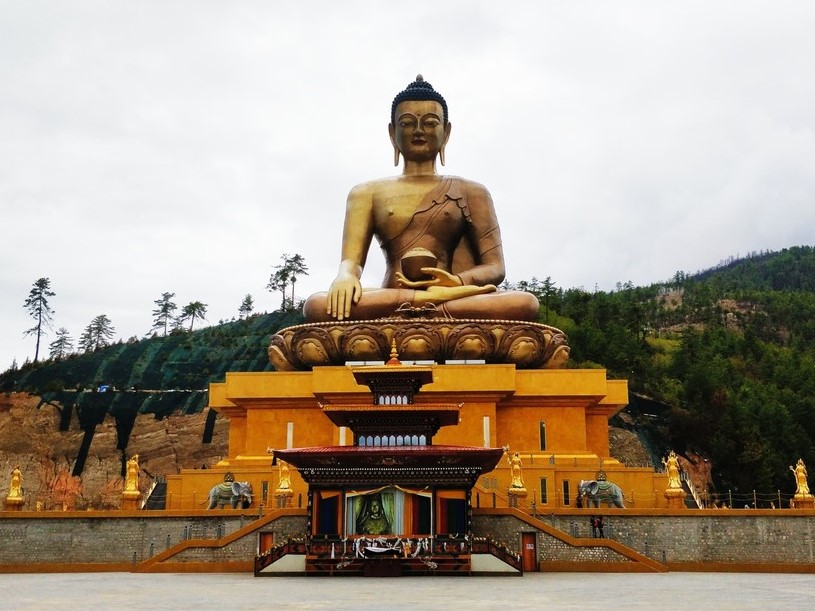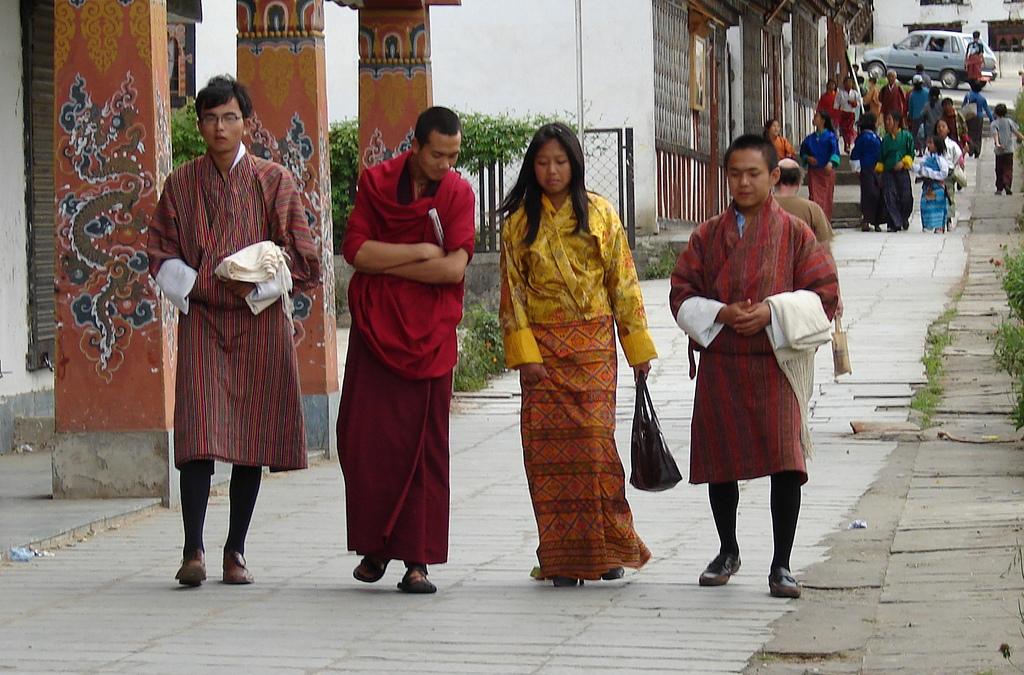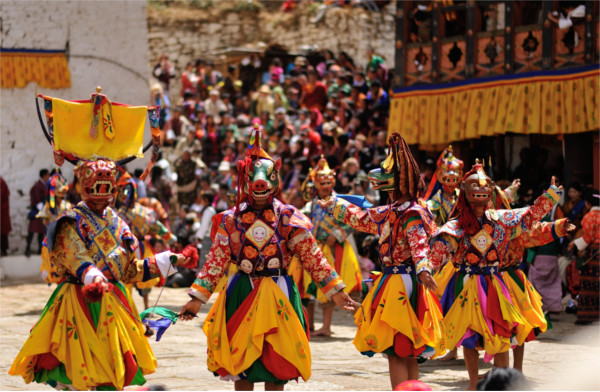Immerse yourself into the amazing Culture of Bhutan
About the Culture of Bhutan; While Bhutan is known as “The Land of Happiness” and one of the smallest countries in the world, its cultural diversity and richness are profound. Where also the strong emphasis is laid on the promotion and preservation of its unique culture and tradition of Bhutan. By protecting and nurturing Bhutan’s living culture and tradition it is believed that it will help guard the sovereignty of the nation.
Religion

Bhutanese society is cantered around the practice of Buddhism in the country, which is the main religion of the nation. Religious beliefs are evidenced in all aspects of life. Prayer flags flutter on hillsides in different forms, offering up prayers to benefit all nearby sentient beings. Every houses in Bhutan host a small white flag on the roof indicating the owner has made his offering payments to appease the local god. And each valley or district is dominated by a huge dzong, or high-walled fortress, which serves the religious and administrative centre of the district and in over all of the nation.
Official Behavioral Code
The Driglam Namzha is the official behaviour and dress code of Bhutan. It governs how citizens should dress in public and how they should behave in formal settings. It also regulates a number of cultural assets such as art and Bhutanese architecture. In English, driglam means “order, discipline, custom, rules, regimen” and namzha means “system,” though the term may be styled “The Rules for Disciplined Behaviour.” That’s how Driglam Namzha brings every Bhutanese to unity in Happiness.
Eating Habits
The Traditional Bhutanese eating habits are very simple and, in general, food is eaten with hands and seating in folding leg position. The Bhutanese family members eats while sitting cross legged on the wooden floor with food first being served to the head of the household first and followed by other.
It is usually women who serve the food and, in most cases, the mother. Before eating, a short prayer is offered and a small morsel placed on the floor as an offering to the local spirits and deities. With modernization, eating habits have changed and in urban areas, people usually eat with cutlery whilst seated at a regular dining table.
Traditionally dishes were cooked in earthenware, but with the easy availability of modern goods, pots and pans have largely replaced their use. A typical Bhutanese meal consists of rice, a dish of Ema Datshi, the country’s favourite dish of chili and cheese, pork, beef curry or lentils.
Bhutanese Funeral
According to the believe of the Bhutanese, death signifies re-birth or a mere passing on to a new life. In keeping with the traditions, elaborate rituals are performed to ensure a safe passage and a good rebirth after death.
Usually, when death happens 7th, 14th, 21st and 49th days after a person’s death are considered especially important and are recognized by erecting prayer flags in the name of the deceased and performing specific religious rituals. While the deceased are normally cremated, funerary practices vary in few cases. In some parts of the country, people typically bury their dead while in some, they carry out ‘Sky Burials’, a process in which the deceased are prepared and left atop mountains to be devoured by vultures in a final act of compassion and generosity. Elaborate and ancient rituals are also conducted on the anniversary of the death with the erection of prayer flags. The relatives and people of the locality come with alcohol, rice or other sundry items to attend such rituals to join the mourning family.
Bhutanese Birth
The Bhutanese birth, the birth of a child is always welcomed with happiness and joy in the family with offering of prayer. In Bhutan extended family and guests are discouraged from visiting during the first three days after the birth because it believes to be impure.
However, on the third day, a short purification ritual is performed after which visitors are welcomed to visit the new born and mother. Bhutanese value children as progenitors of the future and therefore do not discriminate on the sex of the child.
The child is not immediately named within 7 days after the birth, this responsibility is usually entrusted to the head lama (Buddhist priest) of the local temple. The mother and child will also receive blessings from the local deity (natal deity) and it was traditional that the name associated with the deity is given.
Bhutanese Marriage
The Bhutanese Marriage: until just a few decades ago arranged marriages were common and many married among their relatives. In eastern Bhutan cross-cousin marriages were also once common, however, this practice is now becoming less common place among the literate masses and most marriages are based on the choice of the individuals.
Marriages are simple affairs and are usually kept low-key. However, elaborate rituals are performed for lasting unions between the bride and the bridegroom. As the religious ceremony comes to an end, parents, relatives and friends of the couple present the newlyweds with traditional offerings of scarves along with gifts in the form of cash and goods.
In the Western Bhutan, it was commonplace that the husband goes to live in his wife’s house after marriage while the practice in Eastern Bhutan is for the wife to move into the husband’s home. Of course, the newlyweds may also choose to live on their own. Divorce is also an accepted norm and carries no ignominy or disgrace within the country.
Bhutanese Dress

The Bhutanese Dress; One of the most distinctive features of the Bhutanese is their traditional dress, unique garments that have evolved over thousands of years. Men wear the Gho, a knee-length robe somewhat resembling a kimono that is tied at the waist by a traditional belt known as Kera. The pouch which forms at the front traditionally was used for carrying food bowls and a small dagger. Today however it is more accustomed to carrying small articles such as wallets, mobile phones and Doma (beetle nut).
Women wear the Kira, a long, ankle-length dress accompanied by a light outer jacket known as a Tego with an inner layer known as a Wonju.
However, tribal and semi-nomadic people like the Bramis and Brokpas of eastern Bhutan generally wear clothing that differs from the rest of the Bhutanese population. The Brokpas and the Bramis both wear dresses woven either out of Yak or Sheep hair.
Bhutanese wear long scarves when visiting Dzongs and other administrative centres. The scarves worn vary in colour, signifying the wearer’s status or rank. The scarf worn by men is known as Kabney while those worn by women are known as Rachus.
Bhutan Festivals

Bhutan festivals; Bhutan is rich in cultural diversity and this richness is further enhanced by the wide variety of elaborate and colourful religious festivals that are celebrated throughout the country. Every village is known for their unique festival though the most widely known is the annual Tshechu, an annual religious festival.
As the Tshechu begins, the villagers and the general populace dress in their finest clothes and congregate at their local temples and monasteries where these festivals take place. Tshechus are usually occasions to mark important events in the life of the second Buddha, the Indian/Pakistani Tantric master known as Guru Rinpoche or the Precious Master. Various mask dances are performed together with songs and dances for three days on average.
These religious celebrations are lively, high-spirited affairs during which people share meals of red rice, spicy pork, Ema Datshi and Momos (pork/beef dumplings) whilst drinking the heady traditional rice wine known as Ara. These occasions provide the villagers with a respite from the hard labor of their day to day lives and gives the community an opportunity to catch up with family and friends.
Sport
Bhutan national game; Archery is the national sport game in Bhutan, and competitions are held regularly in most villages. It differs from Olympic standards in technical details, such as the placement of the targets and atmosphere. There are two targets placed over 100 m apart and teams shoot from one end of the field to the other. Each member of the team shoots two arrows per round.
Traditional Bhutanese Archery is a social event, and competitions are organized between villages, towns, and amateur teams. There is usually plenty of food and drink complete with singing and dancing. Attempts to distract an opponent include standing around the target and making fun of the shooter’s ability. Darts (kuru) is an equally popular outdoor team sport, in which heavy wooden darts pointed with a 10 cm nail are thrown at a paperback-sized target 10 to 20 m away.

